Photo

SHAPES: Sewing Machine - props and styling by Beverly James Neel
2K notes
·
View notes
Photo
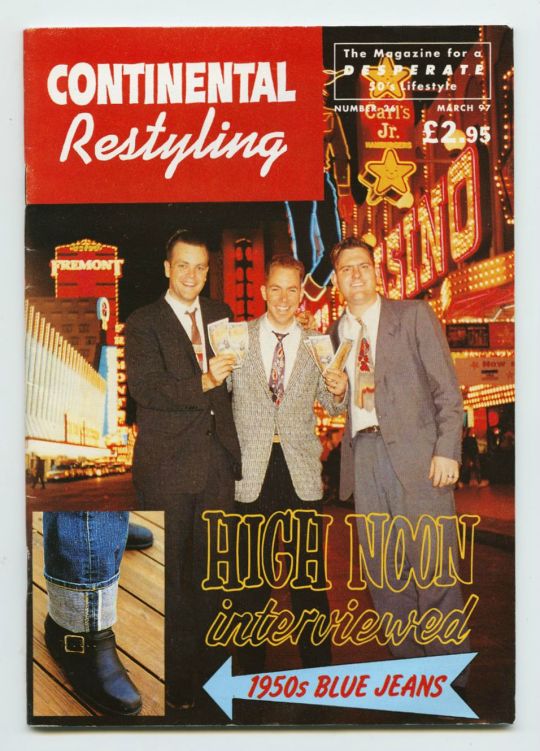
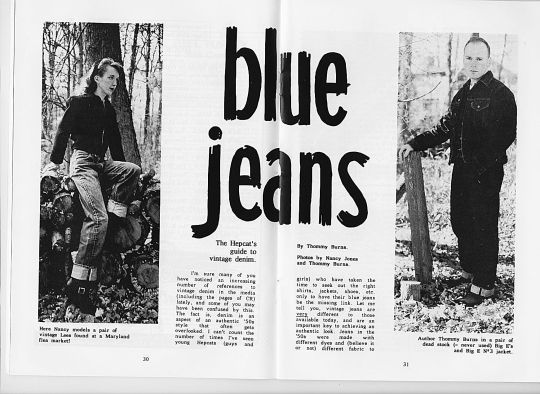
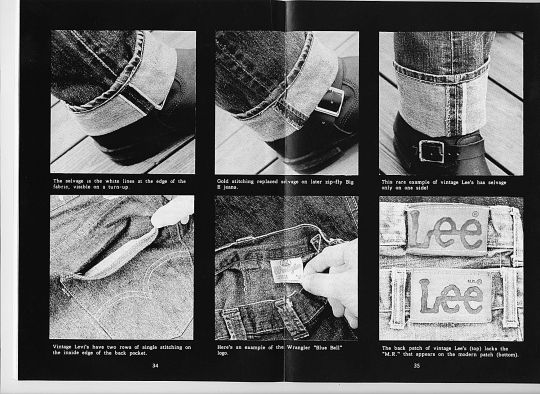
The Meaning of Selvedge Then and Now
Following Jesse’s great post last week on selvedge denim, I thought I’d share some scans from an old 1997 issue of Continental Restyling — an important lifestyle magazine for the Hepcat scene from 1993 until 2000. This was a publication for people passionate about 1950s American culture, rockabilly music, and a certain style of vintage clothes (e.g. circle skirts, rock’n’roll shirts, Hawaiian shirts, and blue jeans). In this issue (now almost 20 years old, if you can believe), we see what the selvedge stripe used to mean to a certain group of vintage clothing enthusiasts.
What Selvedge Used to Mean to Some People
In his article titled “Blue Jeans: The Hepcat’s Guide to Vintage Denim,” Thommy Burns writes:
I can’t count the number of times I’ve seen young Hepcats (guys and girls) who have taken the time to seek out the right shirts, jackets, shoes, etc. only to have their blue jeans be the missing link. Let me tell you, vintage jeans are very different to those available today and are an important key to achieving an authentic look. Jeans in the ‘50s were made with different dyes (believe it or not) and different fabric to those today – they look different when new and the differences become more apparent when they’re worn in.
[…]
Levi’s are my personal favourites. They have always been the world’s most popular jeans and therefore more Cats wore them in the ‘50s, it just stands to reason. Vintage Levi’s have a beautiful ultra-dark indigo colour that gets a distinct and attractive “streaky” grain as it fades.
And how do you spot vintage Levi’s? Well, there are a few things you can look for, but important among them is the selvedge stripe:
Another important facet of vintage Levi’s is the selvedge edge the fabric, visible on a turn up. This is a finished white edge inside the pants, on the outer seam. […] All Levi’s made up to the 1960s had selvedge, this makes it an integral part of an authentic ‘50s look.
What Selvedge Means Today
Jesse’s right when he says that turning up your cuffs to show the little selvedge stripe means “I care.” This was true for vintage clothing enthusiasts in Japan in the ’80s and it’s true for denim enthusiasts today.
It used to mean other things as well, however. It used to mean not only that the denim was woven on narrower shuttle looms, but also something specific about what kind of dyes were used, how the yarns were dyed, and how the resulting jeans were finished. In other words, people cared about that little selvedge stripe because it meant something about how the jeans would fade (sound familiar?). It was an indication of a greater set of production choices, originally made in the mid-century by companies such as Levi’s and Lee.
Today, companies can produce selvedge denim in ways that was never done in the early- to mid-century. Generally speaking, the presence of that little stripe still means that the jeans are meant to fade a certain way, but exactly how those jeans fade is a lot more variable. The connection between selvedge and the broader picture of production methods has evolved a lot over time.
Reducing Clothes to Details
There are dozens of companies now offering selvedge denim. Some even offer “fake selvedge jeans,” where a strip of selvedge is sewn onto the bottom of the cuffs, so they can be flipped up and made to look fashionable.
So what’s the difference between one pair of jeans and another? As Jesse noted, everything. Selvedge denim jeans are defined not just by that little stripe, but also what kind of cotton was used, how that cotton was spun into yarn, how those yarns were dyed, how those dyed yarns were woven into denim, how that denim was made into jeans, and how those resulting jeans were treated in the “finishing” process. All those aspects will determine how a pair of jeans will fade and age over time, and it’s for this quality why some people will choose one pair over another.
Which for me, says something about how we view clothes. Presumably, we got to this place because people reduced jeans to just that little stripe — whether because they equated selvedge with quality, or because they heard selvedge stripes were fashionable right now. This gave companies more of an incentive to produce. As Jesse mentioned, you can buy selvedge denim nowadays for $40 from Converse, $89 from The Gap, or $350 from The Flat Head. In some ways, I think this is great, as not everyone can (or wants to) spend a lot of money on jeans, and it’s good to have options.
On the other hand, it’s useful to remember there’s no “one thing” that will ever tell you the whole story about a garment. That “thing” can include country-of-origin labels, care tags that say 100% cashmere, stitches that look to be hand sewn, buttonholes that are working on sleeves, and little colored stripes on jeans. Clothing production is much more complicated than what those things reveal. When deciding what to purchase, think about the bigger picture of how something was made and don’t rely on just one detail.
133 notes
·
View notes
Photo
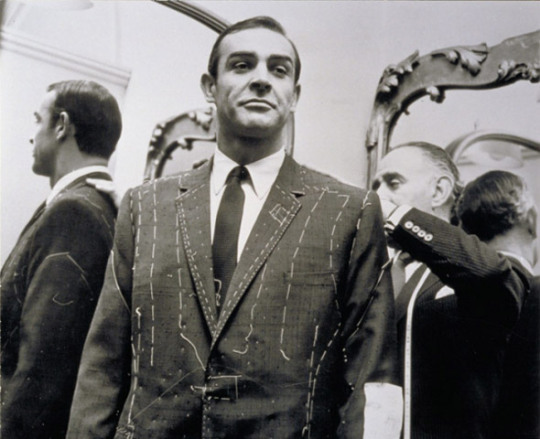
Things You Should Never Say To Your Tailor
IvoryTowerStyle lists twenty things you should never say to your bespoke tailor. A selection:
It’s ok, I’m going to lose 10 pounds.
This looks great. I can’t wait to have a cheaper tailor copy it.
Don’t worry, it’s ok, I read Fred Astaire did this to all his new suits.
I’ll post some pics on the Internet and let you know what needs to be changed.
Could you measure my inseam a few more times?
I’d like no padding in the shoulders, only in the trousers.
Which way do I dress? Up.
Do you accept blog posts as payment?
According to this guy on the Internet, here’s how it should be done…
Read the full post here.
154 notes
·
View notes
Photo
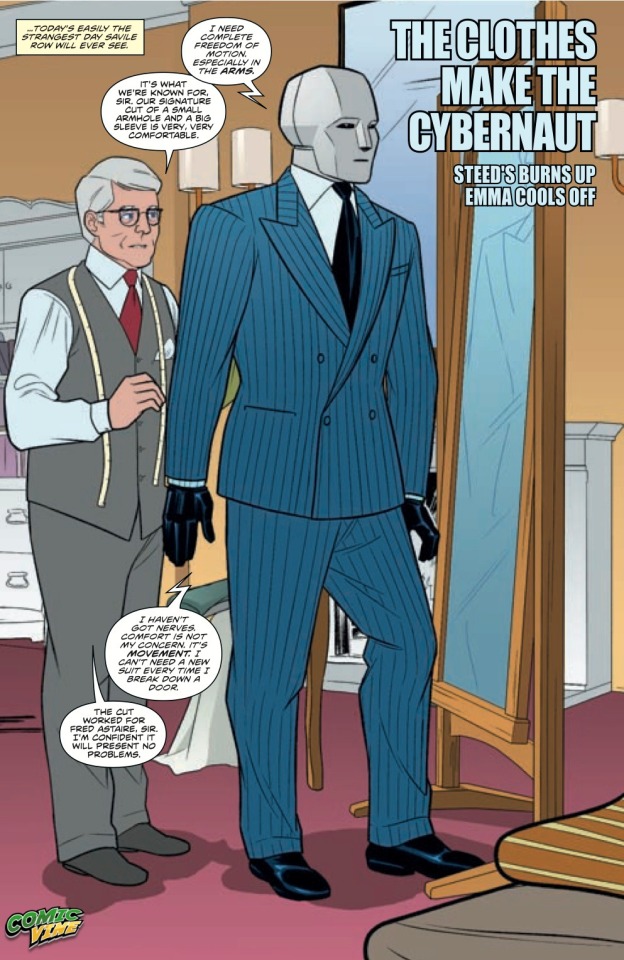
Mister Crew found a strange comic this morning as he was trying to find online photos of Steed jackets (Steed being a bespoke tailor in the UK - a tailor that I use, but is worn much more famously by Voxsartoria).
In case you can’t read the conversation:
Cybernaut: “I need complete freedom of motion, especially in the arms.”
Tailor: “It’s what we’re known for, sir. Our signature cut of a small armhole and a big sleeve is very, very comfortable.”
Cybernaut: “I haven’t got nerves. Comfort is not my concern. It’s movement. I can’t need a new suit every time I break down a door.”
Tailor: “The cut worked out for Fred Astaire, sir. I’m confident it will present no problems.”
Strangely, the cybernaut seems to not be the only one who poses like a robot when wearing Steed.
93 notes
·
View notes
Text
The First Wild One: the genesis of the motorcycle jacket via VICE.com
This jacket is an example of the pride motorcycle riders have for their Schott Perfectos. Even after many long years of loving wear, the owner made sure to keep its tattered Perfecto tag intact.
American ingenuity is responsible for some of the world’s greatest creations. For instance, the cheeseburger is arguably the best all-around food ever and the internet is borderline godlike in its scope. The same goes for a garment that has been adopted by crusty gutter punks, beer-gutted bikers, and yuppies alike: the infallible leather motorcycle jacket. This timeless icon of utilitarian fashion came from the mind of Irving Schott, cofounder of a company now known as Schott NYC, who made history with his iconic asymmetrical jacket design, commonly called the Perfecto.
The scrappy son of Russian immigrants, Irving started his career as a patternmaker for clothing manufacturers in the early 1900s. In 1913, he opened a factory with his brother Jack under the name Schott Bros. in the dingy basement of a tenement building on Manhattan’s Lower East Side. Irving’s first successful products were sheepskin-lined raincoats, which he peddled from door to door. Like any good business, Schott Bros. began to diversify its offerings, bestowing its top-of-the-line coats with the Perfecto brand name. Inspired by Irving’s favorite torpedo-shaped cigars, Perfecto labels were stitched on all of his best leather and wool-lined outerwear.
Stepping into Schott NYC's Union, New Jersey factory is like going back in time. They use machines that date back to the early 1900s, employ men and women who've been making jackets longer than you've been alive, and emphasize quality above all else.
At the time, motorcycles were probably the furthest thing from Irving’s mind, considering they had only recently become commercially available and he didn’t even know how to drive a car. Irving was introduced to the world of boss hogs by a friend who was a member of the Beck family. The Becks were one of the country’s largest Harley-Davidson distributors and published a popular catalog of their wares that was available at motorcycle dealerships across the country. Schott Bros. began manufacturing outerwear for the Beck catalog in 1920, including early iterations of what would become the modern motorcycle jacket.
Up until this point, there wasn’t a single piece of outerwear on the market sturdy enough to be synonymous with riding motorcycles. Wool jackets lacked the ability to protect the rider from the cutting wind at high speeds, and the leather coats of the day were not designed for the hunched-over, extended-arm posture necessary to drive a motorcycle; this was compounded by the fact that wearing either type of jacket on a motorcycle almost guaranteed that anything in the rider’s pockets would be blown into the air while barreling down the road. The advent of the zipper solved these problems and became a key element to Irving’s design.
Modern zippers—invented in 1913, the same year Schott opened its first factory—were at first prohibitively expensive for clothing manufacturers. But then World War I happened, and the US military found several ways to utilize the newfangled enclosure device, which helped drive down the cost and made zippers affordable to the consumer market. Sensing the potential of this new technology, Irving was the first clothier to put a zipper on a jacket in 1925.
In 1928, after a series of designs, Irving created what is now recognized as the modern motorcycle jacket, using the defining diagonal zipper to fasten the enclosure. The angle of the zipper was essential to blocking the wind, and it ensured that the jacket didn’t bunch up when the rider sat down. It was made out of horsehide, produced for Beck under the Perfecto brand, and sold for a whopping $5.50.
Back in those days, the motorcycle jacket was a total oddity, and those bold enough to wear them probably looked peculiar amid the longer formal coats popular at the time. Nearly everything about Schott’s jacket was designed for utility, disregarding style almost entirely. Two decades later, the design had become more common, and the modern mythos of the motorcycle jacket began to take hold. Its adoption into popular culture coincided with its appearance in films like The Wild One (1953), which depicted an angry and aimless Marlon Brando wearing a tightfitting Schott Perfecto as the leader of a motorcycle gang that terrorizes a small town. By the end of the 1950s, schools across the US were banning students from wearing the jacket, which of course only cemented its status as a fashionable symbol of rebellion. This explosion of popularity resulted in the Perfecto name becoming synonymous with Schott’s motorcycle jacket, superseding the brand’s other designs.
The steely-eyed, fuck-everyone cool Brando perfected continued to be embraced over subsequent decades by icons like James Dean, the Ramones, Bruce Springsteen, and Jay-Z—all of whom donned some iteration of Schott’s black leather jacket. Like blue jeans, it is a classic American garment that has been reinterpreted by virtually every major fashion designer and brand: from avant-garde weirdos like Rick Owens to traditionalists like Ralph Lauren to no-name companies that supply cheap and inferior versions to big-box stores. But there’s still nothing like the original; no one has managed to best the motorcycle jackets made by Schott NYC, who continue to use turn-of-the-century machines and hand-cut leather in their manufacturing process.
via VICE.com
Today, of course, we have a multitude of options to get this staple of rebel cool. Although Schott was the first there are a handful of originals that date back to the pre-war years and have their own storied histories and distinct styles. Some notable heavy weights are Lewis Leathers, the English original founded in 1892 and made famous by Joe Strummer of The Clash with its red quilted lining these jackets were worn by some of the top aces of the R.A.F. in the second war (the red lining was actually a symbol of an ace pilot during the war), and a little shout out the hometown boys, Langlitz Leathers from Portland, Oregon which, was founded in 1947 and is still custom making their jackets in the same shop to this day.
(L) Lewis Leathers "Joe Strummer" Lightening (R) Langlitz Leathers Columbia
Im sure their are plenty more out there and please feel free to fill me in on any other historic brands you may know of but, these are the big ones that I am aware of and find myself coveting whenever I job on my motorcycle. I am not sure I am willing to endorse the wearing of "biker" style jackets around unnecessarily (as in when not on a bike or likely to encounter some rough crowds) but, at rough shows or on the back of a motorcycle they are more then at home. They are in fact a necessity.
So, go out and buy a motorcycle, then by a good pair of Chippewa's, and then your classic perfecto.
0 notes
Video
youtube
I know this blog is mostly guy stuff but, I have been thinking a lot about how the right clothes or shoes or accessories or whatever can really make you feel like you can take over the world. I know for me, it so often comes down to fit and simple design but, I think this short video really gets to that love of that connection.
0 notes
Video
HAHAHA... Here Here
vimeo
Hector sends this lovely little cartoon on the subject of short pants. It’s entitled “Half A Pantaloon.”
70 notes
·
View notes
Video
I don't like the sunglasses but, funny ad
youtube
Rub one out for fashion.
81 notes
·
View notes
Photo
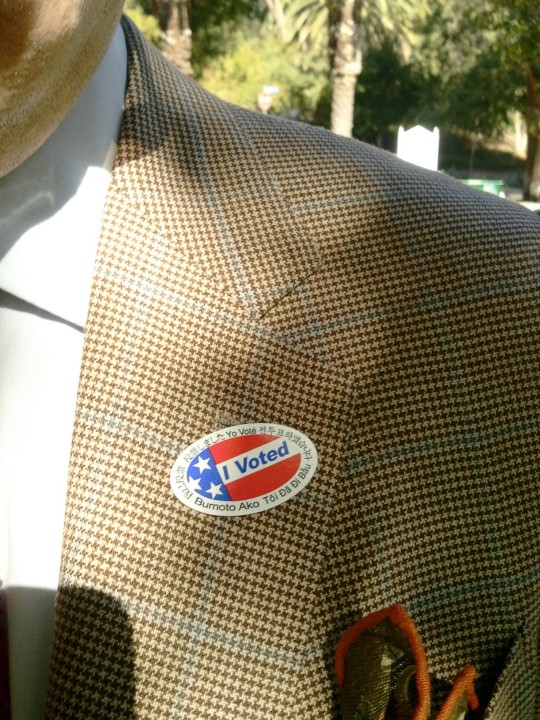
Today’s most important accessory.
171 notes
·
View notes
Text
Trophy Hunting and the Noble Savage
Since the beginning of time man has hunted beast. For sustenance, status, and recreation, as rite, and as tradition. Throughout much of history peopled hunted by necessity. Before the wide spread availability of the awesome variety of meat products we enjoy access to today people either had to raised their own small herds or hunt to get any substantial amount of protein in their diet. Our development of a vast network of food production which makes nutrition available to, theoretically, everyone (even though thats not exactly how it works in reality) is one of the prime factors in the expansion of life expectancy and growth in world wide average height over the last few thousand years.
Archeologists have found many artistic examples from antiquity proving exactly how highly hunting was regarded to ancient civilizations. There are endless images of kings and deities hunting big game animals and mythological creatures to show their power and strength as leaders or warriors. Many ancient taboos are also related to various prey and the mythos associated with them. Some form of semi hunter-gatherer lifestyle endured all the way up until the Age of Discovery when urban growth in Europe really started to take off in a much more pronounced way.
Ancient greek fresco from Tunis of a hunt with lions
As hunting moved from a subsistence activity to a social one, two trends emerged. One was that of the specialist hunter with special training and equipment. The other was the emergence of hunting as a 'sport' for those of an upper social class. As game became more of a luxury than a necessity, the stylized pursuit of it also became a luxury. The evolution of the word 'game' to include an animal that is hunted was a direct result of the development of hunting as sport. Dangerous hunting, such as for lions or wild boars, often done on horseback or from a chariot, had a function similar to tournaments and manly sports. It was considered to be an honourable, somewhat competitive pastime to help the aristocracy practice skills of war in times of peace. In most parts of medieval Europe this trend was enforced as law, making large tracks of land private hunting reserves for the nobles. Poaching could be punishable by death. These laws are where the original stories of Robin Hood began.
As the wealth of Europe grew and their colonial empires grew the aristocracy became increasingly mobil and a wealthy merchant class began to grow. By the 19th century many of the laws regarding hunting in Europe had fallen by the wayside and so was born one of the most iconic British traditions. The fox hunt.
Everyone has seen images of groups of many riding their horses in top hats and red coats, bugler in the midst, chasing their dogs who are hot on the tail of fox. The fox hunt has become a largely symbolic activity but, starting as far back as the 17th century farmers were chasing foxes and killing them as pests. As the industrial revolution came into full swing more people moved away from the country into urban environments and hunting slowly started becoming a leisure activity. With better more accurate guns and few laws or people to enforce them out in the country, hunt clubs began to develop throughout the 19th century. Originally the foxes were hunted because they kept killing the prized pheasants, which the hunt clubs enjoyed, but with the development of new hound breeds trained to handle the new industrialized landscape the fox hunt became a staple activity for the quality in Victorian Europe.
As travel became more luxurious and more reliable people of means with a more adventurous spirit started using their leisure time a bit differently. Foreign tourism began in force and apart from the cultural aspects of the various colonies safaris and big game hunts began to be organized for the enjoyment of the nobles and other wealthy visitors. These safaris were always complete with a team of trackers and local experts, usually of a local tribe, to aid in insuring the comfort and success of the tourists. Although many tribal people were treated as less then human they were still revered for their 'primitive skills' such as, hunting, tracking and understand nature and the land. This concept of the "noble savage" was developed throughout the colonial era as a way to acknowledge the skills they had but, in a subservient manner.
Roosevelt standing with native hunters over a dead lion while on safari in 1910
Ernest Hemingway and Teddy Roosevelt were some of the most famous big game hunters of the modern era shooting all manner of beast from atop horses, elephants, jeeps and camels. This type of 'trophy' hunting, where specific animals are sought out for their beauty, rarity or ferocity to prove the prowess of the hunter gave rise to the concept of a trophy room where mementos of each kill such as mounted heads, taxidermied beasts, pelts, and furniture made from bone could be kept as a monument to their owners skill.
(L) Ernest Hemmingway with his double barrel (R) Teddy Roosevelt sitting on his felled African Buffalo
The trophy room at the Wilbur D. May Museum in Rancho San Rafael Regional Park in Reno Nevada
Modern day hunting as evolved to include a bit of everything from the past. There has been a concerted effort by some to try and move "off the grid" including growing or killing their own food. That is an extreme example but, hunting to this day is one of the most popular sports in America. With sustainability and animal rights on the fore front hunting ethics laid down as far back as Teddy Roosevelt have been another hot topic. Roosevelt wrote of a concept of "fair chase." Simply defined, fair chase is the ethical, sportsmanlike, and lawful pursuit of free-ranging wild game animals in a manner which does not give the hunter an improper or unfair advantage over the animal. The rules of fair chase are simple and seemingly intuitive, treat all things with the respect they deserve. The Boone and Crockett Hunt Club put these rules in writing all the way back in the 19th century.
Obey all applicable laws and regulations
Respect the customs of the locale where the hunting occurs
Exercise a personal code of behavior that reflects favorably on your abilities and sensibilities as a hunter
Attain and maintain the skills necessary to make the kill as certain and quick as possible
Behave in a way that will bring no dishonor to either the hunter, the hunted, or the environment
Recognize that these tenets are intended to enhance the hunter's experience of the relationship between predator and prey, which is one of the most fundamental relationships of humans and their environment
With new technology come new challenges so the Pope and Young Hunt Club have added some more guidelines to fair chase.
From any power vehicle or power boat
By Jacklighting or shining at night
By the use of any tranquilizers or poisons
While inside escape-proof fenced enclosures
By the use of any power vehicle or power boats for herding or driving animals, including the use of aircraft to land alongside or to communicate with or direct a hunter on the ground
By the use of electronic devices for attracting, locating or pursuing game or guiding the hunter to such game, or by the use of a bow or arrow or firearm to which any electronic device is attached
1 note
·
View note
Text
Rain Slicker
Oilskin (oilies) and waxed cotton clothing owe their origins to the great age of the sailing ship and the age of navigation. Its hard to pin point exactly when oilskin techniques began but, its probably a safe bet that, in some form or another, that some rudimentary version has existed as long as sea travel. With the invention of the compass and increasingly better maps in the late middle ages, the beginning of long distance exploration all around the world was begun.
Italianate Harbour Scene with the Monument of Ferdinand I de’ Medici at Leghorn
Sailing ships were traditionally rigged with linen sails and so, with the fabric in such abundance fishermen and sailors used it for everything. From clothes to wadding. At some point these professional sea folk found that by applying boiling linseed oil (from flax seed) to the linen and letting it set the linen was rendered waterproof and was excellent material for making waterproof capes. However, the linen was heavy and the linseed oil turned yellow and stiffened over time. Oilskin proved to be a great way to keep yourself, as well as anything else, dry in very wet environments such as the deck of a ship but, it was also difficult proved to be dangerous to make and restrictive to wear. All the same, cloaks, chests, and document folds were all made from this versitle (and compared to leather or fur, light weight) material to protect their contents from the elements.
High-Tech Modern Oilskins in the midst of a squall
Cotton sails eventually replaced linen. Cotton was lighter and could be woven into a tighter and stronger fabric. It also led to lighter and stronger clothing such as oiled cotton jackets, coats and trousers. The jackets became especially popular among fishermen who would paint them bright colors with ordinary house paint to make themselves more visible if and when they went over board. The next major evolution came in the mid-19th century when linseed oil was replaced by parafin wax. Parafin wax treated garments maintained their flexibility and were also breathable so condensation wouldn't build up. This led to more sophisticated garments providing the wearer with significantly more movement and utility. Although the cut, style, and technology in waterproofing changed over the centuries the need for men of the sea to be easily seen in a squall stayed consistent throughout.
(L) Norman Rockwell's Saturday Evening Post with a fisherman in a slicker
(R) the Gorton's Fisherman in his Sou-Wester
When plastics and synthetic fabrics were invented in the mid-20th century traditional oilskins became obsolete. "Space age" technology made slickers better, lighter, easier to make, more comfortable, and infinitely customizable. Everyone in American has the classic image of the Gordon's fisherman from the fish sticks box or the Norman Rockwell-esk idea of the stalwart seaman battling the ocean in his bright yellow slicker. Another advantage of modern technology is that man "professional" slickers these days include floatation devices, GPS location, built in harness, and in some cases a small tool kit.
If he can rock it so, can you
Now, of course these professional level outfits are extreme for the average person but, in the cold wet grey months ahead having a good coat to keep you dry is a must. Having some color to brighten up your day is also never a bad thing plus, the sunshine yellow acts the same for you in the city as it does for the fishermen in the sea. It will get you noticed. Don't wait to long, get out there and enjoy in the rain in style.
0 notes
Text
A Boys First Pocket Knife
A lot of boys first pocket knives came as gifts from grandpas or dads, sometimes uncles or brothers many times against the best wishes of mothers. In any case, the pocket knife is an indispensable tool for the growing young man and is an emblem of his burgeoning manhood, an invitation to the fraternity of man. I remember getting my first Swiss Army knife from my uncle when I was young and all the adventures it helped me through as well as all the trouble it helped me stir up. I have it still to this day, worn but, still ready for action.
Folding knives of many different designs have been around for thousands of years. The oldest found to date is nearly 2600 years old. Although it was simple, a bone handle and a single iron blade, it was the beginning of long history of innovation. The origins of the modern Swiss Army knife lay with the Romans. The old empire was renowned for its metal workers and many different versions of multi-facetted tools have been found throughout the Mediterranean including everything from knives, spikes, forks, and spoons in a handheld package. You can imagine how, for a legion on the move, a pocket knife could come in handy all the time. Sadly, the skills to develope a working multi-function pocket knife were lost in Europe during the dark ages so, although many people carried swords, daggers or other sharp edged implements very few if any pocket knifes were available.
Roman army knife from 200 AD. Made of silver with an iron blade it has a fork, knife, spoon, spatula, and a spike.
A post-n-groove knife call the Navaja has been a popular choice in Spain since the 15th century. It made a distinct clicking sounds when opened and closed which became its trademark. The only other pocket knife available until the 18th century was a heavy crude tool known as the Jack Knife. it wasn't until the 18th century when the Sheffield knife-makers designed and built what is widely recognized as the first modern pocket knife. The Sheffield pen knife became de rigueur among the educated set who used it to, of course, cut the nibs of their quills.
the year knife, mid-1970s
In 1822 as a display of their craft, Joseph Rodgers and Sons Ltd. of Sheffield debuted their Year Knife with 1,822 blades to mark the date. It was designed to have another blade added to it every year until the end of the millennium in 2000 when the knife would finally be finished with its 2000th blade, ending, of course, far to large for anyones pocket. The firm went on to create the Norfolk Sportsman's Knife in 1851 which took two full years in production and ended up with 75 blades. These two examples seem pretty extreme but, they show the level of innovation in the world of folding knives in the mid-19th century. By 1893 an American cutlery catalogue had over 1,500 pocket knives listed for sale showing exactly how popular they had become. but, it wasn't until 1897 when a man by the name of Karl Elsener decided there was no good reason for the Swiss Army to be buying its knives from Germany that the most popular and recognizable knife in the world today got its start. The red body and silver crossed shield have become the standard for modern pocket knives.
1891 Swiss Army soldier knife
Pocket knives have also been an essential tool for soldiers throughout American history. New York and new Hampshire required their militias to carry pocket knives during the American Revolution. Even George Washington toted one around as he led his troops. The U.S. Navy began issuing them to sailors during the Civil War and they became standard issue for all American GIs during WWII.
Although in the first half of the 20th century pocket knives were popular among young boys and many carried them around in their pockets or ruck sacks always prepared for the occasional whittle or game of mumblypeg (a knife game that involves throwing a knife into the ground as close to your opponents foot as possible without hitting them), public concern quickly arose over children's safety and knives were deemed unsuitable. As the century continued adolescents who still did carry knives gained a progressively more negative reputation especially with the rise of gang violence in the urban areas.
Boy Scouts playing mumbly peg
Today, it seems that we have hit a fork in the road you could say. One side lead to more and more authoritarian control and heavy security measures such as the Bureau of Homeland Security or any international airport and the other leads to peoples interest to become more self sufficient and seeing things like pocket knives as tools as opposed to weapons. In my humble opinion, if a boy is old enough to be in Cub Scouts, he's old enough to get his first knife but, with great power comes great responsibility so, with these young'n's there must be a few ground rules and it has to be approached delicately.
Rule #1: Make it the first gift. Of course a boy is going to be excited when he gets his first knife so, make it the first gift and wrap the snot out of subsequent gifts so that he can demonstrate his instant manliness by allowing him to test out his new prize.
Rule #2: Casually have an old black of wood or a stick conveniently lying in the room. "What's that stick doing mom?" "Oh, that stick? Oh, i was just rearranging a few things, and... who wants another piece of cake?" Let the whittling commence.
Rule #3: Have a special place. The problem isn't cutting off a finger, it's finding the knife. This is an excellent time to start the "it's your personal belonging-don't ask me where it is!" rule.
and of course...
Rule #4: Only use it with Mom & Dad around... at least for now. One day, there will be independence with this great gift but, that time is not now.
a boy whittling a boat
All that being said, a nice pocket knife can be a great gift for anyone no matter the age but, how do you decide what to get. Pocket knives can be broken down into three major types. The jack knife is simple and sturdy with just a single hinge where as a pen knife has two hinges one on either end. The term pen knife is also used to describe a very small two hinge knife that could be worn without ruining the line of your suit but, for our purposes two hinges is the important thing and finally the multipurpose knife is more or less the standard today, it boasts many different tools not simply just knives and it's what made the Swiss Army knife famous. Within each category there are many different varieties some of which I have displayed below.
the Trapper, a type of jack knife generally with two blades. A clip and a spey blade
L-R Whittler, Stockman, and Congress, all types of pen knives. The Whittler is characterized by its three blades. The Stockman is generally distinguished by its sowbelly shape (kind of like an S) and a clip, sheep's foot, and spey blade. The Congress is marked by its convex front and four blades. *the above knives are all from CRKT classics
Swiss Army Fieldmaster knife
As with most things the more personal the better. Vintage and heirloom knives are fantastic. I am personally a big fan of engravings and hand made things. With a little effort its not all that more expensive to have something made custom as opposed to buying from a store. Finally one of the greatest things about pocket knives is that if you take care of them they will last a lot longer then you and somebody else will see that engraving one day and wonder about the story behind it. You become a part of the legend of that knife.
1 note
·
View note
Text
Welcome Back!!
Sorry for the absence... I've had a bit of a rough couple months so, I'm working to get back onto a solid writing schedule. I hope you stick with me and remember I'd love to hear from all of you. New ideas are always welcome...
I declare boot and sweater season officially OPEN!!
0 notes
Photo
More Mens Wear humor. Should be back with new articles in the next couple of weeks. Yay! for fall
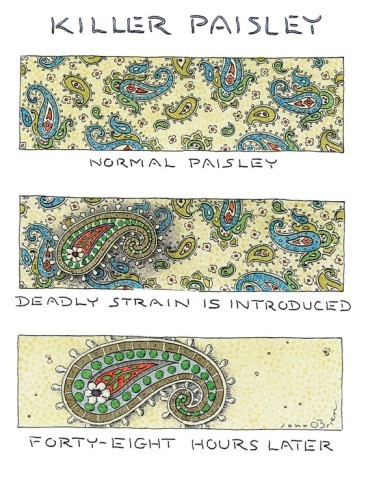
From this week’s New Yorker style issue; by John O’Brien. Buy a print here.
1K notes
·
View notes
Text
Summer break
Sorry for the absence yall. I have been a bit busy with school and unmotivated to write. So, hopefully Ill get my act together and get it done for next week.
Hope everyones summer is going well. till then...
0 notes
Photo

“When I was young there were beatniks. Hippies. Punks. Gangsters. Now you’re a hacktivist. Which I would probably be if I was 20. Shuttin’ down MasterCard. But there’s no look to that lifestyle! Besides just wearing a bad outfit with bad posture. Has WikiLeaks caused a look? No! I’m mad about that. If your kid comes out of the bedroom and says he just shut down the government, it seems to me he should at least have an outfit for that.”
- John Waters on the sorry style of today’s rebels (emphasis mine)
206K notes
·
View notes
Text
Cut-off Casual
Cut-off shorts are not only comfortable and easy but, these days they are very much on trend. With memories of stick ball in the col-du-sac and making out with Winnie Cooper under the bleachers there are few things better for a wet hot American summer. On the west coast we are known for our laid back attitude and relaxed style, there is no better time then the long hot days of summer to show it off. Cut-off shorts are a must for the beach, bike, and park, festivals, BBQs, and pools.
Michael Bastian in his signiture cut-off shorts. perfect laid back summer time look all around
Unlike your saggy baggy shorts from high school, cut-offs have the advantage of once being pants. The (hopefully) slim leg and shorter draw make for a much sleeker short and when you cut them yourself you can fit them just right. The key with shorts is to get the proportion just right. A shorter draw looks better with shorter legs just like a longer draw begs for a bit longer to keep the ratio in line. Bigger legs can handle a bit longer short where as a longer short will make skinny legs look even skinnier.
a good visual on how to wear shorts but, remember proportion is top priority. remade from Primer via
Now that your wearing your cut-offs everyday remember to put some attitude into it. These aren't slacks and you aren't going to the country club. A bit of a roll on your shorts legs can be great or a funky belt that you normally wouldn't think about wearing, this is the place. Go a little crazy... it SUMMER!!
TIPS ON CUTTING YOUR OWN
Remember when cutting your pants mark them, then cut them a few inches longer then you think you might want. Cutting more is easy, adding fabric isn't.
Mark one leg then fold together and cut both legs at the same time to make sure they come out even.
A few inches above the knee is a good safe bet. If you have bigger thighs err on the longer side and if you have thinner thighs on the shorter side but, never longer then a couple inches above the knee.
After you make you final cut at the length you want wash them to get the perfect fray and wear them till they fall off.
Have a pair of scissors handy every time you wash them to trim back the ever growing fray.
2 notes
·
View notes